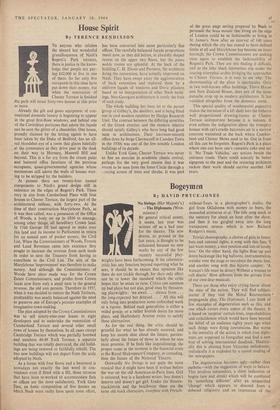House Spirit
By T.ERENCE BENDIXSON
Already the gilt and gesso equipment of con- ventional domestic luxury is beginning to appear in the great first-floor windows, and behind one of the Corinthian porticoes that adorn the facade can be seen the glitter of a chandelier. One house, proudly claimed by the letting agents to have been taken by the Duke of Bedford, has an all- red bloodshot eye of a room that glares balefully at the commuters as they drive past in the dusk on their way to Hornsey, Muswell Hill and beyond. This is a far cry from the cream paint and battered office furniture of the previous occupants, quasi-governmental agencies whose mementoes still adorn the walls of houses wait- ing to be stripped by the builders.
At present there are twenty-four named components to Nash's grand design still in existence on the edges of Regent's Park. These vary in size from Cumberland Place with four houses to Chester Terrace, the largest part of the architectural tableau, with forty-two. At the time of their construction Marylebone Park, as it was then called, was a possession of the Office of Woods, a body set up in 1810 to manage, among other things, all hereditary Crown land. In 1760 George III had agreed to make over this land and its income to Parliament in return for an annual sum of pocket money, the Civil List. When the Commissioners of Woods, Forests and Land Revenues came into existence they sought to increase the revenue from such lands in order to save the Treasury from having to contribute to the Civil List. The aim of the Marylebone 'improvement' was therefore to make money. And although the Commissioners of Woods have since made way for the Crown Estate Commissioners, and profits from Crown lands now form only a small item in the general revenue, the old aim persists. Therefore in 1957, when it was decided to restore the Nash Terraces, profitability was neatly balanced against the need to preserve one of Europe's premier examples of imaginative town-making.
The plan adopted by the Crown Commissioners was to sell ninety-nine-year leases to eight developers and to undertake the restoration of Cumberland Terrace and several other small rows of houses by themselves. In all cases except Cambridge Terrace which was partially bombed and numbers 44-49 York Terrace, a separate building that was totally destroyed, the old build- ings are being restored or faithfully rebuilt. The two new buildings will not depart from the scale adopted by Nash.
As a house with four floors and a basement is nowadays not exactly the last word in con- venience even if fitted with a lift, those terraces that have been re-worked to accommodate flats or offices are the most satisfactory. York Gate East, an Ionic composition of five houses on which Nash must really have spent some effort, has been converted into some particularly fine offices. The carefully balanced facade proportions result now, as they did before, in absurdly shaped rooms on the upper two floors, but the piano nobile rooms are splendid. At the back of the building C. H. Elsom and Partners, the architects doing the restoration, have actually improved on Nash. They have swept away the agglomeration of back extensions and replaced them by a uniform façade of windows and Doric pilasters based on an interpretation of other Nash build- ings. Neo-Georgian architecture is rarely the fruit of such study.
The whole building has been let to the parent group of Gilbey's, the distillers, and is being fitted out in cool modern opulence by Design Research Unit. The contrast between the differing severities of the Greek exterior and the modern interior should satisfy Gilbey's who have long had good taste in architecture. Their icecream-smooth office done by Serge Chermayeff in Camden Town in the 1930s was one of the few notable London buildings of its decade.
Unlike York Gate, Chester Terrace was never so fine an exercise in academic classic revival, perhaps for the very good reason that it was meant to be seen from the Inner Circle through a t.,,mcing screen of trees and shrubs. It was part
of the great stage setting prepared by Nash to persuade the beau monde that living on the edge of London could be as fashionable as living in St. James's. Now after an interval of 140 years during which the city has ceased to have defined limits at all and Marylebone has become an inner borough, the Crown Commissioners are seeking once again to establish the fashionability of Regent's Park. .They are not finding it difficult, and as the lithe black limousines slip under the soaring triumphal arches bridging the approaches to Chester Terrace, it is easy to see why. The showmanship of the place is spectacular. Only in two well-known office buildings, Thorn House and New Zealand House, does any of the same panache crop up in modern architecture. It has vanished altogether from the domestic scene.
This special quality of insubstantial pageantry makes the intrusion of a lift shaft into the hitherto well proportioned drawing-rooms at Chester Terrace unimportant because it is indoors. It even softens the indignation about the trumpery houses with cat's-cradle balconies set in a narrow concrete wasteland at the back where Cumber- land and Chester Mews used to be. Out in front all this can be forgotten. Regent's Park is a place where one can have one's romantic cake and eat it. 'No Trade Vehicles,' say notices beside the entrance roads. There could scarcely be better signposts to the past and the restoring architects reckon their work should survive another 140 years.


































 Previous page
Previous page